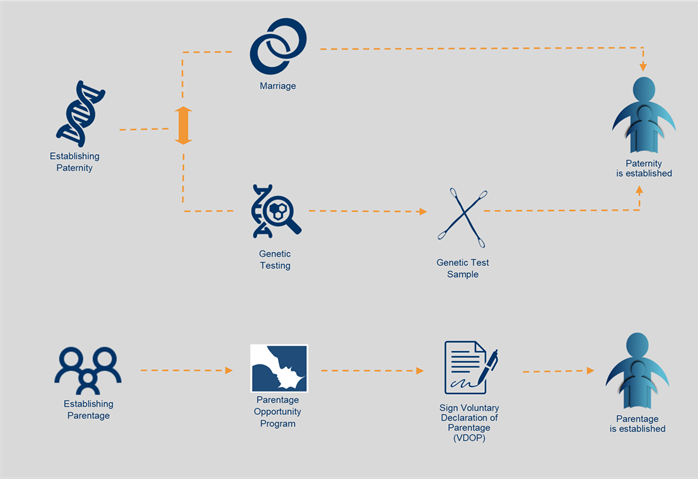Overview:
Parentage and paternity are processes for determining the legal parents of a child. Unmarried parents and parents that had their child through assisted reproduction can voluntarily establish legal parentage through the Parentage Opportunity Program (POP).
Paternity (fatherhood) is automatically determined when a child is conceived during marriage. If paternity is at issue, the legal father can be determined through POP or genetic testing.
Process Flows:
Establishing Paternity (Top Flow):
Step 1: Establishing Paternity The process begins when paternity needs to be legally established.
From here, there are three possible paths:
Path A - Marriage: If the child was conceived during marriage, paternity is automatically established, and no further action is needed. Result: Paternity is established.
Path B - Genetic Testing: If paternity is disputed or uncertain, genetic testing may be required.
- Genetic Test Sample - A genetic test sample is collected from the potential father and child.
- Result: Paternity is established based on the test results.
Establishing Parentage (Bottom Flow):
Step 1: Establishing Parentage The process begins when legal parentage needs to be established for unmarried parents or parents who had a child through assisted reproduction.
Step 2: Parentage Opportunity Program Parents participate in the Parentage Opportunity Program (POP), a voluntary process for establishing legal parentage.
Step 3: Sign Voluntary Declaration of Parentage (VDOP) Both parents sign a legal document called a Voluntary Declaration of Parentage.
Result: Parentage is established Once the VDOP is signed, legal parentage is officially established.
Note: The dotted lines in the graphic show the different pathways available depending on your specific circumstances. Both processes result in legal establishment of parental rights and responsibilities.
